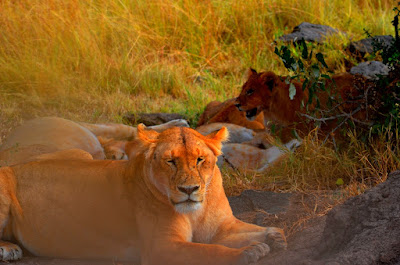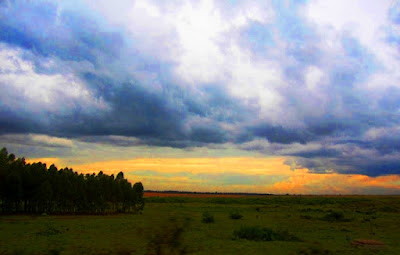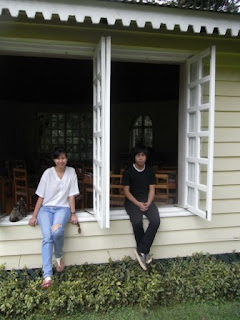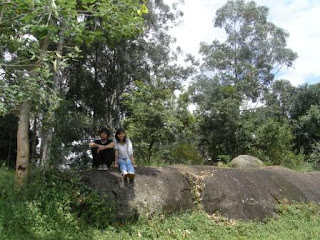Cape Town

Journey to Tanzania
Kenya Wild Life March 2012:
Masai Mara and Lake Nakuru
Photo courtesy of Bill Gunawan
Katarak
Naiberi Swans
These safari pictures are unique, because the one who did the safari was the geese not me.
We were dining at the Naiberi Camp restaurant when I heard the familiar squealing voices of the geese, voices which I had not heard since I left my home village about forty years ago.
Took my camera and headed down to the creek where I found a group of domestic geese swimming at creek.
The geese really enjoyed their safari, and did not even notice my presence.
I was so blessed to capture them swimming, bathing, playing, grooming and sometimes stretching their necks into the water, probably to find snails, fish or water insects.
Life is really good.
Kibabet
Long winding and muddy road that leads to Kibabet nature beauty:
A vast ocean of tea plantations.
Green hills with cyprus, pine and eucalyptus forests, and corn field.
Untouched lime caves under the water-falls.
Blooming aloe vera, aromatic African basil, many other wild flowers and white tailed-monkey.
Akagera river Rwanda
Kenya hidden Beauty- Mlango waterfalls
The bus stopped at grassy savanna, where a boy and a girl were attending their sheep. I took some pictures of this wild beauty, while the bus unloaded the students.
This is probably an African spring, because most of the of the wild plants are blooming, especially the African Aloevera plants.
Then we walked down to the waterfalls.
The nature is really amazing.
The formation of stone hills, boulders, and waterfalls
make you feel like little ants crawling among the gravels.
Living Eden -Iten
I like watching National Geography program called living Eden.
However, being inside the living Eden is more enjoyable than merely watch one on TV screen.
Look at the following pictures of the living Eden I captured in Iten.
I think you must agree with me that
National Geography must have missed this one.

Birei river
Birei river is about 20 minutes drive from our campus.
Sunday morning I decided to go there. At the gate I met Nixon, a student who voluntarily offered his motorcycle and took me down to the river. We found the water has overflowed and even covered the bridge. Several children were playing and swimming at bridge. Actually I wanted to go over the bridge to a pool where the birds, otters and mongooses are, but then I met a man named Choge, who suggested me to come after lunch when there are not too many children around, because the birds and animals will come out after the children left. However Nixon got call that he must return to the dorm, so we decided to leave after taking pictures with children.
Early morning at the university dam with Chumba
I joined Chumba, the man who works at the university snake park canoeing at the university dam. He has put small trap to catch some fish for the Biology lab. I asked him, if I could pick some wild fruits and plants which grow along the dam. The two of us then spent about thirty minute canoeing and taking pictures. We took turn canoeing, if I took pictures Chumba will canoe and if I did the canoeing Chumba will be the one who took pictures.

Journey to Tanzania
Kenya Wild Life March 2012:
Masai Mara and Lake Nakuru
Photo courtesy of Bill Gunawan
Katarak
Naiberi Swans
These safari pictures are unique, because the one who did the safari was the geese not me.
We were dining at the Naiberi Camp restaurant when I heard the familiar squealing voices of the geese, voices which I had not heard since I left my home village about forty years ago.
Took my camera and headed down to the creek where I found a group of domestic geese swimming at creek.
The geese really enjoyed their safari, and did not even notice my presence.
I was so blessed to capture them swimming, bathing, playing, grooming and sometimes stretching their necks into the water, probably to find snails, fish or water insects.
Life is really good.
Kibabet
Long winding and muddy road that leads to Kibabet nature beauty:
A vast ocean of tea plantations.
Green hills with cyprus, pine and eucalyptus forests, and corn field.
Untouched lime caves under the water-falls.
Blooming aloe vera, aromatic African basil, many other wild flowers and white tailed-monkey.
Akagera river Rwanda
Kenya hidden Beauty- Mlango waterfalls
The bus stopped at grassy savanna, where a boy and a girl were attending their sheep. I took some pictures of this wild beauty, while the bus unloaded the students.
This is probably an African spring, because most of the of the wild plants are blooming, especially the African Aloevera plants.
Then we walked down to the waterfalls.
The nature is really amazing.
The formation of stone hills, boulders, and waterfalls
make you feel like little ants crawling among the gravels.
Living Eden -Iten
I like watching National Geography program called living Eden.
However, being inside the living Eden is more enjoyable than merely watch one on TV screen.
Look at the following pictures of the living Eden I captured in Iten.
I think you must agree with me that
National Geography must have missed this one.

Birei river
Birei river is about 20 minutes drive from our campus.
Sunday morning I decided to go there. At the gate I met Nixon, a student who voluntarily offered his motorcycle and took me down to the river. We found the water has overflowed and even covered the bridge. Several children were playing and swimming at bridge. Actually I wanted to go over the bridge to a pool where the birds, otters and mongooses are, but then I met a man named Choge, who suggested me to come after lunch when there are not too many children around, because the birds and animals will come out after the children left. However Nixon got call that he must return to the dorm, so we decided to leave after taking pictures with children.
Early morning at the university dam with Chumba
I joined Chumba, the man who works at the university snake park canoeing at the university dam. He has put small trap to catch some fish for the Biology lab. I asked him, if I could pick some wild fruits and plants which grow along the dam. The two of us then spent about thirty minute canoeing and taking pictures. We took turn canoeing, if I took pictures Chumba will canoe and if I did the canoeing Chumba will be the one who took pictures.
 |
| Chumba is picking the wild fruit, there are also many bird's nests here |
 |
| picking wild plants |
 |
| safe haven for the bird |
 |
| dam is full of water during the rainy season |
Crested Crane
 |
| These beautiful birds had been chosen as the title of university year book |
I took a three hour walk for a mini safari to the university farm and dairy with our MBA students who came from Rwanda. During this safari we spotted a group of crested cranes feeding in the cow pastures.
I remember when we just came back from our evacuation on January 2008, I saw a group crested cranes flying slowly above our house in line of three or four like a group of soldiers marching back from a successful battle.
Today I find them flocking gracefully on the green pastures, they are really stunning beautiful creatures.
Savannah and the surrounding Rift valley villages and towns
The following pictures were taken from the public van - matatu, while we were traveling from campus to Nairobi passing through several towns: Nakuru, Naivasha, Narok, and Gilgil. This dry savannah land known as Rift valley is actually vast plains and hills where people build ranch and raise cattle. There are no big trees, but acacias and giant cactus. Most of the restaurants along this road offer Nyama choma or roasted mutton/beef.
 |
| The message would be different should he waved and smiled....... parch land harsh people. |
Landscape of Kericho Tea Plantation
Kakamega Forest
Kakamega forest is about 30 minutes from our campus, a beautiful tropical forest. The Rondo retreat and camp site is a very beautiful garden, we spent our time taking picture here, before we headed for the Kakamega river. We also visited the tower and butterfly garden, this place is really beautiful.
A visit to Masai Mara and Lake Nakuru
Our daughter - Tasha came to stay with us after she graduated from Universitas Klabat. She wanted to do voluntary services for about 4 months as her tithe, because she was able to finish her accounting degree in about 40 months. We were so grateful that she was accepted to do this here at the UEAB accounting office, an experience Tasha enjoyed so much.
Our son - Jonan also was just graduated from Maxwell Adventist Academy in Ongata Rongai.
It was during this vacation time that we took time to visit Masai Mara and Lake Nakuru game parks. Knowing that I am not professional photographer, I tried so hard to capture the wild life with my digital camera. The result was not so disappointed. At least we had experienced the one we only watch in Animal Planet or National Geography channels.
It was during this vacation time that we took time to visit Masai Mara and Lake Nakuru game parks. Knowing that I am not professional photographer, I tried so hard to capture the wild life with my digital camera. The result was not so disappointed. At least we had experienced the one we only watch in Animal Planet or National Geography channels.
The following pictures were taken from Lake Nakuru and Masai Mara game parks, Kenya.






























































































































































